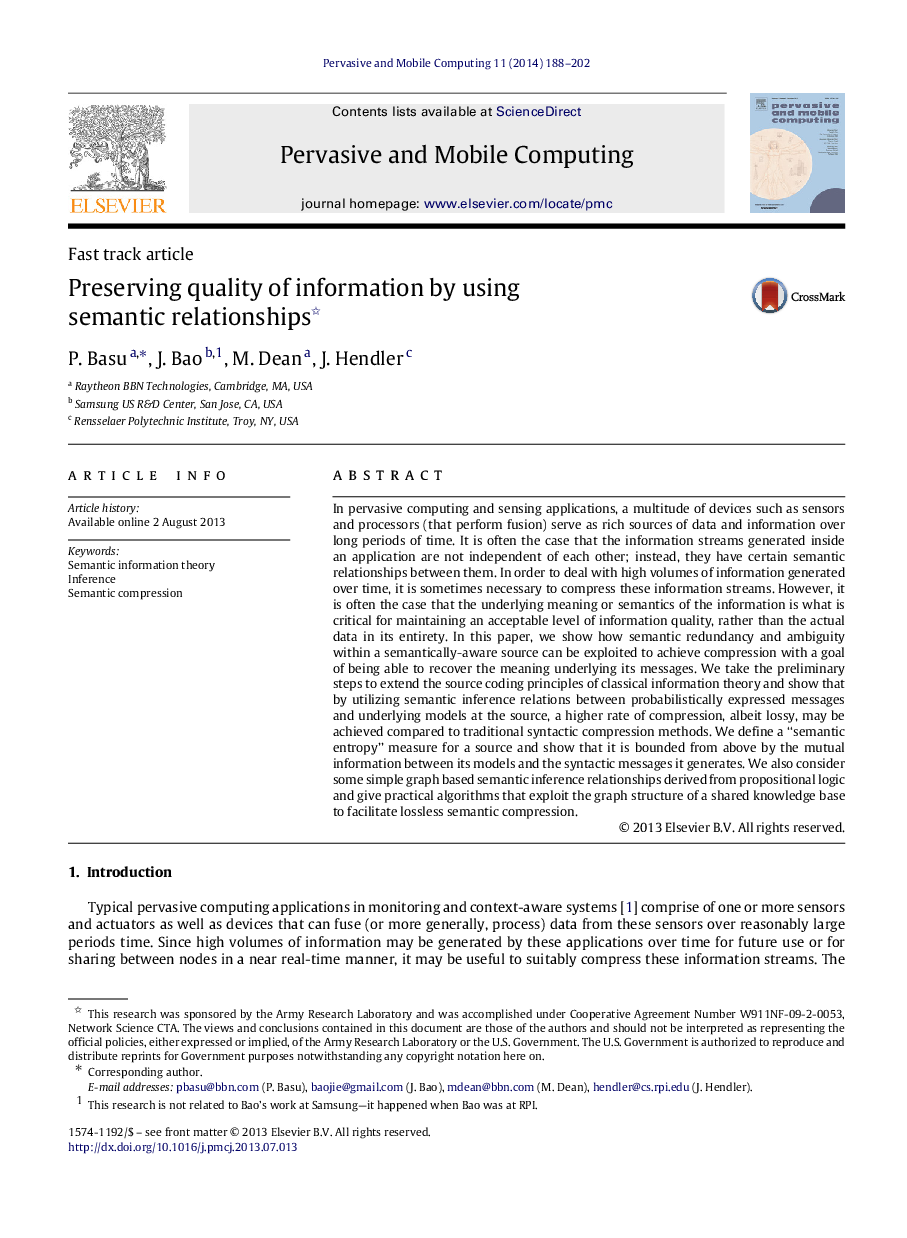| کد مقاله | کد نشریه | سال انتشار | مقاله انگلیسی | نسخه تمام متن |
|---|---|---|---|---|
| 6888885 | 697798 | 2014 | 15 صفحه PDF | دانلود رایگان |
عنوان انگلیسی مقاله ISI
Preserving quality of information by using semantic relationships
ترجمه فارسی عنوان
حفظ کیفیت اطلاعات با استفاده از روابط معناشناختی
دانلود مقاله + سفارش ترجمه
دانلود مقاله ISI انگلیسی
رایگان برای ایرانیان
کلمات کلیدی
نظریه اطلاعات معنایی، استنتاج، فشرده سازی معنایی،
ترجمه چکیده
در برنامه های محاسباتی فراگیر و سنجش، بسیاری از دستگاه ها مانند سنسورها و پردازنده ها (که همپوشانی را انجام می دهند) به عنوان منابع غنی از اطلاعات و اطلاعات در طول مدت زمان طولانی خدمت می کنند. اغلب موارد این است که جریان اطلاعات تولید شده درون یک برنامه مستقل از یکدیگر نیست؛ در عوض، آنها روابط معناشناختی خاصی بین آنها دارند. برای مقابله با حجم زیاد اطلاعات تولید شده در طول زمان، گاهی اوقات لازم است فشرده سازی این جریان اطلاعات. با این حال، اغلب موارد این است که معنای اساسی و معناشناسی اطلاعات مهم است که برای حفظ سطح قابل قبول کیفیت اطلاعات به جای داده های واقعی در تمامیت آن حیاتی است. در این مقاله، ما نشان می دهیم که چگونه افزونگی معنایی و ابهام در یک منبع معنایی آگاهانه می تواند برای دستیابی به فشرده سازی با هدف توانایی بهبود معانی اساسی پیام های آن مورد بهره برداری قرار گیرد. ما گام های اولیه را برای گسترش اصول برنامه نویسی کد تئوری اطلاعات کلاسیک و نشان می دهیم که با استفاده از روابط استنتاج معنایی بین پیام های بیان شده و احتمالا در منبع، روش های فشرده سازی. ما یک آنتروپی معنایی را تعریف می کنیم؟ اندازه گیری برای یک منبع و نشان می دهد که آن را از بالا با اطلاعات متقابل بین مدل های آن و پیام های نحوی که تولید می کند محدود شده است. ما همچنین برخی از روابط استنتاج معنایی معناداری بر اساس منطق گویا را به دست می آوریم و الگوریتم های عملیاتی را به کار می بریم که ساختار گراف یک پایگاه دانش مشترک را برای تسهیل فشرده سازی معناشناختی از دست رفتن استفاده می کنند.
موضوعات مرتبط
مهندسی و علوم پایه
مهندسی کامپیوتر
شبکه های کامپیوتری و ارتباطات
چکیده انگلیسی
In pervasive computing and sensing applications, a multitude of devices such as sensors and processors (that perform fusion) serve as rich sources of data and information over long periods of time. It is often the case that the information streams generated inside an application are not independent of each other; instead, they have certain semantic relationships between them. In order to deal with high volumes of information generated over time, it is sometimes necessary to compress these information streams. However, it is often the case that the underlying meaning or semantics of the information is what is critical for maintaining an acceptable level of information quality, rather than the actual data in its entirety. In this paper, we show how semantic redundancy and ambiguity within a semantically-aware source can be exploited to achieve compression with a goal of being able to recover the meaning underlying its messages. We take the preliminary steps to extend the source coding principles of classical information theory and show that by utilizing semantic inference relations between probabilistically expressed messages and underlying models at the source, a higher rate of compression, albeit lossy, may be achieved compared to traditional syntactic compression methods. We define a “semantic entropy” measure for a source and show that it is bounded from above by the mutual information between its models and the syntactic messages it generates. We also consider some simple graph based semantic inference relationships derived from propositional logic and give practical algorithms that exploit the graph structure of a shared knowledge base to facilitate lossless semantic compression.
ناشر
Database: Elsevier - ScienceDirect (ساینس دایرکت)
Journal: Pervasive and Mobile Computing - Volume 11, April 2014, Pages 188-202
Journal: Pervasive and Mobile Computing - Volume 11, April 2014, Pages 188-202
نویسندگان
P. Basu, J. Bao, M. Dean, J. Hendler,
